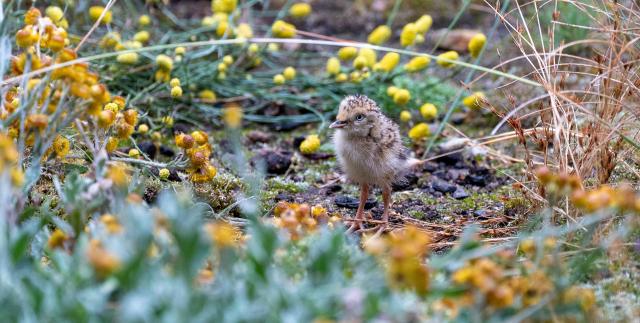An adorable, critically endangered chick is taking its first wobbly steps at Werribee Open Range Zoo, marking a significant milestone in threatened species conservation.
The newly hatched Plains-wanderer chick, affectionately referred to by the zoo’s threatened species keepers as a “pompom on stilts”, weighs just five grams at hatching and is one of the rarest birds in the world with only 1000 remaining in the wild.
Werribee Open Range Zoo natives life sciences manager Yvette Pauligk said the golden-spotted chick with exceptionally long legs is thriving in the zoo’s conservation space while being closely observed by threatened species keepers working to save the species from extinction.
“The chick is progressing really well and is absolutely beautiful, it looks like a pom-pom on stilts as their legs are already adult-size when they’re born,” Ms Pauligk said.
“This little one is extremely valuable to the Plains-wanderer breeding program and is a candidate to be released into the wild in the future.”
In evolutionary terms, plains-wanderers are genetically distinct from any other species on the planet and are the last family on their evolutionary line.
Werribee Open Range Zoo has successfully bred a total of 38 plains-wanderers since the zoo’s threatened species centre opened in 2017.
While plains-wanderers are typically born in clutches of four or five eggs, this miracle-chick is the only one that hatched in January.
Ms Pauligk said threatened species conservation work is an ever-evolving field and the team is taking the opportunity to learn from the new chick.
“Things don’t always go to plan in threatened species conservation and there’s still so much we’re learning about this quirky bird species. This chick is so precious precisely because it helps us to better understand how best to breed plains-wanderers,” she said.
The fluffy Australian-native chick is growing more independent each day and beginning to move away from its father who is tasked with protecting his offspring in their first few weeks of life.
“The dad’s responsibility is to keep that little chick warm for the first three weeks, but now the chick is starting to become more confident and explore on its own, which are positive behaviours that we’re thrilled to see,” Ms Pauligk said.
The plains-wanderer was once widespread throughout the grasslands of Queensland, New South Wales, Victoria and South Australia.
Habitat destruction, impacts from over grazing, introduced predators, and extreme weather events resulted in the species’ population plummeting 85 per cent during the past 20 years, driving them to the brink of extinction.
Today, they live in two remaining strongholds in Victoria’s Northern Plains and the New South Wales Riverina.
Ms Pauligk said Werribee Open Range Zoo’s breeding programs and wild release trials are two of many important conservation techniques helping to re-establish a self-sufficient and thriving wild plains-wanderer population.
“It’s essential that we and other organisations around Australia breed these birds to have an insurance population in case something happens in the wild, such as the recent floods we had in Victoria. But it’s also important that we do have a healthy population of birds that we can release into the wild when those conditions are right,” Ms Pauligk said.
The plains-wanderer is one of 27 Australian priority threatened species that Zoos Victoria is committed to saving from extinction.
Every visit to Werribee Open Range Zoo contributes to this fighting extinction work.








